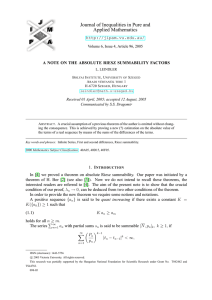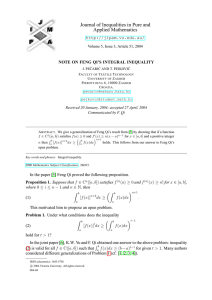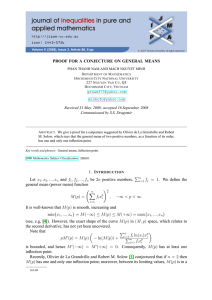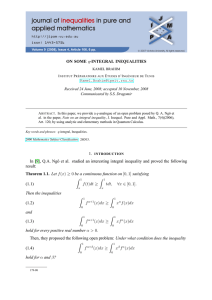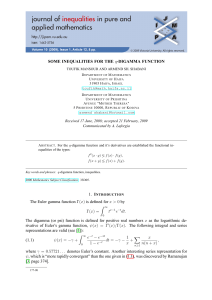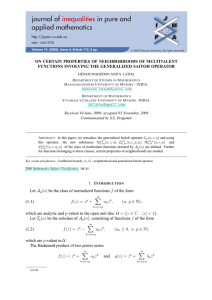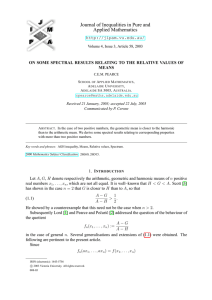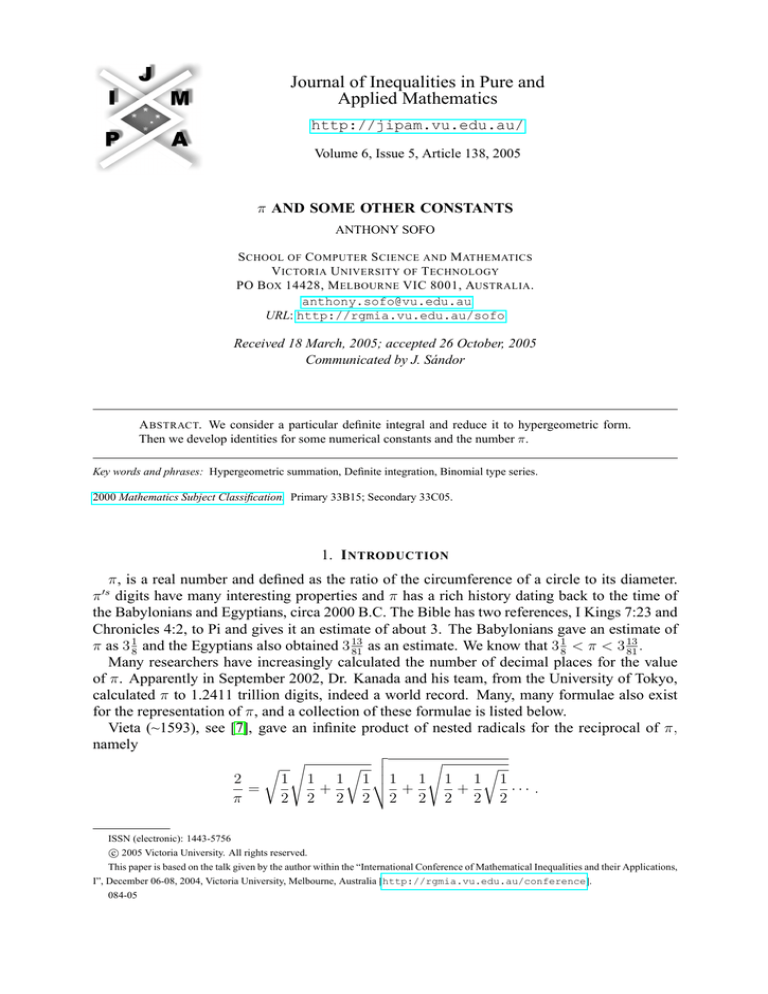
Journal of Inequalities in Pure and
Applied Mathematics
http://jipam.vu.edu.au/
Volume 6, Issue 5, Article 138, 2005
π AND SOME OTHER CONSTANTS
ANTHONY SOFO
S CHOOL OF C OMPUTER S CIENCE AND M ATHEMATICS
V ICTORIA U NIVERSITY OF T ECHNOLOGY
PO B OX 14428, M ELBOURNE VIC 8001, AUSTRALIA .
anthony.sofo@vu.edu.au
URL: http://rgmia.vu.edu.au/sofo
Received 18 March, 2005; accepted 26 October, 2005
Communicated by J. Sándor
A BSTRACT. We consider a particular definite integral and reduce it to hypergeometric form.
Then we develop identities for some numerical constants and the number π.
Key words and phrases: Hypergeometric summation, Definite integration, Binomial type series.
2000 Mathematics Subject Classification. Primary 33B15; Secondary 33C05.
1. I NTRODUCTION
π, is a real number and defined as the ratio of the circumference of a circle to its diameter.
π digits have many interesting properties and π has a rich history dating back to the time of
the Babylonians and Egyptians, circa 2000 B.C. The Bible has two references, I Kings 7:23 and
Chronicles 4:2, to Pi and gives it an estimate of about 3. The Babylonians gave an estimate of
π as 3 18 and the Egyptians also obtained 3 13
as an estimate. We know that 3 18 < π < 3 13
.
81
81
Many researchers have increasingly calculated the number of decimal places for the value
of π. Apparently in September 2002, Dr. Kanada and his team, from the University of Tokyo,
calculated π to 1.2411 trillion digits, indeed a world record. Many, many formulae also exist
for the representation of π, and a collection of these formulae is listed below.
Vieta (~1593), see [7], gave an infinite product of nested radicals for the reciprocal of π,
namely
v
s
r u
r
r s
u
2
1 1 1 1 t1 1 1 1 1
=
+
+
+
··· .
π
2 2 2 2 2 2 2 2 2
0s
ISSN (electronic): 1443-5756
c 2005 Victoria University. All rights reserved.
This paper is based on the talk given by the author within the “International Conference of Mathematical Inequalities and their Applications,
I”, December 06-08, 2004, Victoria University, Melbourne, Australia [http://rgmia.vu.edu.au/conference].
084-05
2
A NTHONY S OFO
Wallis (~1650), see [7], gave
∞ π Y
1
=
1−
.
4 r=1
(2r + 1)2
Leibnitz (~1670), see [7], gave the very slow converging series
∞
π X (−1)r
=
.
4
2r + 1
r=0
Newton (~1666) admitted being ashamed at having computed π to fifteen decimal places, by
the formula
√
Z 1√
4
3 3
π=
+ 24
x − x2 dx
4
0
√
3 3
3 1
1
1
5
=
+2−
+
+
+
+ ···
4
4 5 7 · 24 9 · 27 11 · 212
√
∞ 3 X 2k
1
3 3
+2−
=
k
4
4 k=0
16k (k + 1) (2k + 5)
Euler (~1750) gave many representations of π including:
"
#
n
X
π
1
1
1
= lim
+
+ 4n
.
2 + j2
2 n→∞ n 6n2
n
j=1
Ramanujan (~1914) has also given many representations of π and its reciprocal, including:
√
∞
1
2 2 X (4r)! (1103 + (2 · 5 · 7 · 13 · 29) r)
= 4
.
π
3 · 112 r=0
(r!)4 (22 · 32 · 11)4r
For a fuller account of Ramanujan’s work the interested reader is referred to the books of Berndt
[4].
Comtet (1974) gave
∞
23 · 34 · 5 X 1
4
.
π =
17
r4 2rr
r=1
D. and G. Chudnovsky (1989) gave
∞
X
1
(−1)r (6r)! 13 · 1045493 + 2 · 32 · 7 · 11 · 19 · 127 · 163r
·
.
= 12
1
π
(r!)3 (3r)!
(218 · 33 · 53 · 233 · 293 )r+ 2
r=0
Bailey, Borwein and Plouffe (1996) gave
∞
X
1
4
2
1
1
(1.1)
π=
−
−
−
.
r 8r + 1
16
8r
+
4
8r
+
5
8r
+
6
r=0
Bellard (1997) gave
"∞
#
X 3P (r)
1
π= 2 2
− 24 · 5 · 254741 ,
r−1
3 · 5 · 11 · 13 · 23 r=1 7r
2
2r
where
P (r) = −13 · 29 · 2351653r5 + 193 · 16193509r4 − 52 · 7 · 79 · 212873r3
+ 5 · 206392559r2 − 2 · 98441137r + 23 · 13 · 43 · 2459.
J. Inequal. Pure and Appl. Math., 6(5) Art. 138, 2005
http://jipam.vu.edu.au/
π
AND
OTHER C ONSTANTS
3
Lupas [10], gave
∞
X
π =4+
2k
k
k
(−16)
k=1
(40k 2 + 16k + 1)
.
2
4k 2
2k
(4k
+
1)
2k
The original Lupas formula contained a minor misprint which has been corrected here.
Borwein and Girgensohn (2003), wrote
π = ln 4 + 10
∞
X
r=1
1
2r r
3r
r
.
Sofo [16] has given
∞ √
X
π √
4r
1
= 2 + ln
2−1 +
r
2
2r 16 (2r + 1) (4r + 1)
r=0
and
∞
π2 =
1308 12 X
+
135
5 r=1 r2
2r
r
4r
.
(r + 1) (2r + 1) (2r + 3)
Many other representations of π exist, including the famous Machin-type formulae such as
π
= 4 arctan
4
1
1
− arctan
.
5
239
There are also many other connections of π and other mathematical constants, including:
eiπ + 1 = 0,
π 3 + 8π = 56 − 8
∞
X
r=1
(−1)r
,
r (r + 1) (2r + 1)3
∞
X (−1)r (r!)2
π2
2
= 3 ln φ +
, where φ is the Golden ratio
6
(2r)! (2r + 1)2
r=0
and
π 2 = −12e3
∞
X
r=1
1
cos
r2
9
rπ +
q
2
(rπ) −
.
32
A selection of some series expansion representations of π including some of the above is
given by Sebah and Gourdon [15].
There are other nice articles and books relating to π including [2, 3, 6, 7, 8, 11, 12].
The aim of this paper is to derive representations of π, as well as some other constants, by the
consideration of a particular definite integral. The following integral will now be investigated.
J. Inequal. Pure and Appl. Math., 6(5) Art. 138, 2005
http://jipam.vu.edu.au/
4
A NTHONY S OFO
2. T HE I NTEGRAL
Theorem 2.1. For k, m and α real positive numbers and a ≥ 1, then
Z 1
a
xm
(2.1)
I (a, k, m, α) =
dx
k α
0 (1 − x )
∞
X
(α)r
(2.2)
=
r! (rk + m + 1) ark+m+1
r=0
m+1
, α 1
k
(2.3)
= T0 2 F1
m+1+k
ak
k
m+1
m+1
1
−k
(2.4)
=
B 1 − α,
− B 1 − a ; 1 − α,
,
k
k
k
where
1
,
(m + 1) am+1
T0 =
(2.5)
(b)s is Pochhammer’s symbol defined by
(b)0 = 1
(2.6)
(b) = b (b + 1) · · · (b + s − 1) =
s
Γ(b+s)
,
Γ(b)
Γ (b) is the classical Gamma function, 2 F1 [· ·] is the Gauss Hypergeometric function, B (s, t)
is the classical Beta function and
Z z
B (z; s, t) =
us−1 (1 − u)t−1 du
0
is the incomplete Beta function.
Proof.
Z
1
a
I (a, k, m, α) =
0
Z
1
a
=
0
xm
dx
(1 − xk )α
∞
X
−α
r
(−1)
xkr+m .
r
r=0
where we have utilised
1
β
(1 + z)
=
∞ X
−β
r
r=0
zr
and from
−β
r
r
= (−1)
β+r−1
r
(−1)r (β)r
=
r!
we have
Z
I(a, k, m, α) =
0
1
a
∞
X
(α)
r
r=0
r!
xkr+m .
Reversing the order of integration and summation and substituting the integration limits we
obtain the result (2.2). The result (2.4) is obtained by the use of the substitution u = 1 − xk .
J. Inequal. Pure and Appl. Math., 6(5) Art. 138, 2005
http://jipam.vu.edu.au/
π
AND
OTHER C ONSTANTS
5
Binomial sums are intrinsically associated with generalised hypergeometric functions and if
from (2.2) we let
(α)r
(2.7)
Tr =
,
r! (rk + m + 1) ark+m+1
then we get the ratio
(α + r) r + m+1
Tr+1
k
(2.8)
= k
Tr
a (r + 1) r + m+1+k
k
where T0 is given by (2.5). From (2.5) and (2.2) we can write
m+1
1
,
α
k
I(a, k, m, α) = T0 2 F1
m+1+k
ak
k
1
m+1
m+1
−k
=
B 1 − α,
− B 1 − a ; 1 − α,
,
k
k
k
which is the result (2.3). We can now match (2.2) and (2.3) so that
m+1
∞
X
1
(α)r
,
α
k
=
T
F
0
2
1
m+1+k
ak
rk+m+1
r!
(rk
+
m
+
1)
a
k
r=0
1
m+1
m+1
−k
=
B 1 − α,
− B 1 − a ; 1 − α,
,
k
k
k
and the infinite series converges for a−k < 1.
In a previous paper, Sofo [17] has utilised (2.1) for the case a = 1 and developed identities
for π and other constants, such as
p
√
√ ∞
7
15p!
30 + 6 5 + 1 − 5 X
30 r
,
for p = 0, 1, 2, 3, . . .
π=
7
r! (30r + 30p + 7)
4 30
p
r=0
√
Remark 2.2. Bailey, Borwein, Borwein and Plouffe see [7] utilised (2.1) for a = 2, α = 1,
k = 8 and m = β − 1, β < 8 to prove the new formula (1.1). Subsequently Hirschhorn [9] has
shown that (1.1) can be obtained from standard integration procedures.
The following lemma will be useful in the consideration of the integral (2.1).
Lemma 2.3. For p = 0, 1, 2, . . . the following well-known identities are given by Beyer [5]
p
(−1)p X
2p + 1
j
2p+1
(2.9)
sin
x = 2p
(−1)
sin ((2p + 1 − 2j) x)
2
p
j=0
and
(2.10)
sin2p+2 x
=
1
22p+1
"
2p + 1
p
p
− (−1)
p
X
j=0
j
(−1)
2p + 2
p
#
cos ((2p + 2 − 2j) x) .
The integral (2.1) can be simplified as follows. Consider the case k = 2; then from (2.1)
Z 1
a
xm
(2.11)
I (a, m, 2, α) =
dx.
2 α
0 (1 − x )
The following lemma concerns the integral (2.11).
J. Inequal. Pure and Appl. Math., 6(5) Art. 138, 2005
http://jipam.vu.edu.au/
6
A NTHONY S OFO
Lemma 2.4.
(i) For m = 2p + 1, 2α = 2q + 1; p = 0, 1, 2, . . . , and q = 0, 1, 2, . . .
Z θ∗
Z 1
a
sin2p+1 θ
x2p+1
(2.12) I (a, m, 2, α) =
dx
=
dθ
2q+1
cos2q θ
0 (1 − x2 ) 2
0
1
1 − 2q
−2 1 − 2q
=
B
,p + 1 − B 1 − a ;
,p + 1
2
2
2
q−1
j
j 1 2p+2 Y
1 2p+2
X
(−1)
2 (p − q + i) − 1
1
a
a
+
=
·
2q−1
∗
2(q−j)−1
∗
θ
cos
θ i=1 2 (q − i) + 1
2q − 1 cos
j=1
q
Y
2 (p − q + i) − 1 (−1)p
q
+ (−1)
2 (q − i) + 1
22p
i=1
#
p
X
(−1)s
2p + 1
×
{1 − cos ((2p − 2s + 1) θ∗ )} .
2p
−
2s
+
1
s
s=0
∗
where x = sin θ and θ = arcsin a1 .
Note, the middle term in the right hand side of (2.12) is identically zero for q = 1 and
only the last sum applies for q = 0.
(ii) For m = 2p + 2, 2α = 2q + 1; p = 0, 1, 2, . . . , and q = 0, 1, 2, . . .
Z 1
Z θ∗
a
x2p+2
sin2p+2 θ
(2.13) I (a, m, 2, α) =
dθ
2q+1 dx =
cos2q θ
0 (1 − x2 ) 2
0
1
1 − 2q
3
3
−2 1 − 2q
=
B
,p +
−B 1−a ;
,p +
2
2
2
2
2
2p+3
2p+3
q−1
j
1
X (−1)j 1
Y 2 (p − q + i + 1)
1
a
· a2q−1 ∗ +
=
2q − 1 cos
θ
cos2(q−j)−1 θ∗ i=1 2 (q − i) + 1
j=1
q
Y
2 (p − q + i + 1)
1
2p + 1 ∗
q
+ (−1)
θ
2 (q − i) + 1
22p+1
p
i=1
#)
p
X
(−1)s
2p + 2
p
∗
− (−1)
sin ((2p − 2s + 2) θ )
.
2p − 2s + 2
s
s=0
where x = sin θ and θ∗ = arcsin a1 .
Note, the middle term in the right hand side of (2.13) is identically zero for q = 1 and
only the last two terms apply for q = 0.
Proof.
(i) From
Z
I (a, m, 2, α) =
0
θ∗
sin2p+1 θ
dθ,
cos2q θ
integrating by parts once leads to
"
#
θ∗
Z θ∗
1
sin2p+2 θ
sin2p+1 θ
I (a, m, 2, α) =
− (2p + 3 − 2q)
dθ
2q − 1 cos2q−1 θ 0
cos2q−2 θ
0
Z ∗
1 2p+2
2p − 2q + 3 θ sin2p+1 θ
a
=
−
dθ,
(2q − 1) cos2q−1 θ∗
2q − 1
cos2q−2 θ
0
J. Inequal. Pure and Appl. Math., 6(5) Art. 138, 2005
http://jipam.vu.edu.au/
π
AND
OTHER C ONSTANTS
7
and repeated integration by parts gives us
(2.14) I (a, m, 2, α)
=
(2q −
1 2p+2
a
1) cos2q−1
θ∗
+
1 2p+2
a
cos2(q−j)−1 θ∗
q−1
X
(−1)j
j=1
j
Y
2 (p − q + i) + 1
2 (q − i) + 1
Z ∗
q
Y
2 (p − q + i) + 1 θ
q
+ (−1)
sin2p+1 θdθ.
2
(q
−
i)
+
1
0
i=1
i=1
Substituting (2.9), from Lemma 2.3, into (2.14) and integrating, results in (2.12) hence
part (i) of the lemma is proved.
(ii) The proof of part (ii) of the lemma follows the same footsteps as part (i).
The following lemma is given and will be useful in the simplification of the left hand side of
(2.17) and (2.18).
Lemma 2.5. For r = 0, 1, 2, . . . and q = 1, 2, 3, . . . then
q−1
q + 21 r
1 2r Y 2r + 2ρ + 1
(2.15)
= r
,
r!
4
r ρ=0 2ρ + 1
and for q = 0,
1
2 r
1
= r
r!
4
(2.16)
2r
r
.
Proof. For q = 0, then
1
2 r
Γ r + 12
1 2r
= r
=
.
r!
4
r
r!Γ 12
This result is well known and is also given by Wilf [18].
For q ≥ 1, let
q−1
q + 21 r
1 2r Y 2r + 2ρ + 1
P (q) :=
= r
r!
4
r ρ=0 2ρ + 1
then
3
2 r
(2r + 1) Γ
=
P (1) =
r!
2
Γ
1
2
3
2
1
2 r
r!
,
and from (2.16)
2r + 1 2r
P (1) =
,
4r
r
which satisfies the right hand of (2.15) for q = 1.
Consider
q + 32 r
Γ q + r + 32
P (q + 1) =
=
r!
r!Γ q + 32
2q + 2r + 1 Γ q + r + 12
=
2q + 1
r!Γ q + 12
q + 21 r
2q + 2r + 1
=
2q + 1
r!
J. Inequal. Pure and Appl. Math., 6(5) Art. 138, 2005
http://jipam.vu.edu.au/
8
A NTHONY S OFO
and from (2.15)
P (q + 1) =
2q + 2r + 1
2q + 1
1
4r
2r
r
Y
q−1
2r + 2ρ + 1
1
= r
2ρ + 1
4
ρ=0
2r
r
Y
q
2r + 2ρ + 1
2ρ + 1
ρ=0
hence the lemma is proved.
For k = 2 the following theorem now applies.
Theorem 2.6.
(i) For m = 2p + 1, 2α = 2q + 1; p = 0, 1, 2, . . . , q = 0, 1, 2, . . . ,
(2.17)
Qq−1 2r+2ρ+1
∞ X
q + 21 r
2r
ρ=0 2ρ+1
=
2r+2p+2
r
r
r! (2r + 2p + 2) a
4 (2r + 2p + 2) a2r+2p+2
r=0
r=0
p + 1, 21 (2q + 1) 1
∗
= T0 2 F1
a2
p+2
1
1 − 2q
−2 1 − 2q
=
B
,p + 1 − B 1 − a ;
,p + 1
2
2
2
2p+2 j
q−1
1 2p+2
X
Y 2 (p − q + i) + 1
(−1)j a1
a
=
+
(2q − 1) cos2q−1 θ∗ j=1 cos2(q−j)−1 θ∗ i=1 2 (q − i) + 1
∞
X
q
+ (−1)
q
Y
2 (p − q + i) + 1
i=1
2 (q − i) + 1
p
(−1)p X (−1)s
2p + 1
×
{1 − cos ((2p − 2s + 1) θ∗ )}
22p s=0 2p − 2s + 1
s
"
#
where
T0∗ =
1
(2p + 2) a2p+2
and θ∗ = arcsin a1 .
(ii) For m = 2p + 2, 2α = 2q + 1; p = 0, 1, 2, . . . , q = 0, 1, 2, . . . ,
(2.18)
∞
X
r=0
q + 12 r
r! (2r + 2p + 3) a2r+2p+3
Qq−1 2r+2ρ+1
∞ X
2r
ρ=0 2ρ+1
=
r (2r + 2p + 3) a2r+2p+3
r
4
r=0
1
1
1
(2p
+
3)
,
(2q
+
1)
∇
2
= T0 2 F1 2
1
a2
(2p + 5)
2
1
1 − 2q
3
3
−2 1 − 2q
B
,p +
−B 1−a ;
,p +
=
2
2
2
2
2
J. Inequal. Pure and Appl. Math., 6(5) Art. 138, 2005
http://jipam.vu.edu.au/
π
=
(2q −
1 2p+3
a
1) cos2q−1
θ∗
AND
+
OTHER C ONSTANTS
9
1 2p+3
a
cos2(q−j)−1 θ∗
q−1
X
(−1)j
j
Y
2 (p − q + i + 1)
2 (q − i) + 1
q
Y
2 (p − q + i + 1)
1
2p + 1 ∗
q
+ (−1)
θ
2p+1
2
(q
−
i)
+
1
2
p
i=1
#)
p
s
X
2p
+
2
(−1)
− (−1)p
sin ((2p − 2s + 2) θ∗ )
,
2p
−
2s
+
2
s
s=0
j=1
i=1
where
T0∇ =
and θ∗ = arcsin
1
a
1
(2p + 3) a2p+3
.
The proof of Theorem 2.6 follows directly from Lemma 2.4 , (2.14) and Lemma 2.5.
Some examples will now be given expressing π and other constants in terms of an infinite
series.
3. I LLUSTRATIVE E XAMPLES
Example 3.1. From (2.17) with q = 2, a = 2 and θ∗ = π6 , we have
2
√
3
8
− 2 (2p − 1) + 8 (−1)p (2p − 1) (2p + 1)
3
p
X
(−1)s
2p + 1 n
πo
×
1 − cos (2p − 2s + 1)
2p − 2s + 1
s
6
s=0
∞ X
2r (2r + 1) (2r + 3)
=
.
r (r + p + 1)
r
16
r=0
Hence, for p = 7,
√
∞
X
3 · 222
32 · 11
3=
− 6
7 · 163 · 6367 2 · 7 · 163 · 6376 r=0
Example 3.2. From (2.18) with q = 2, a =
16p (p + 1)
8 − 4p + √ 2p+3
3
2p + 1
p
p
X
p
− (−1)
s=0
2r
r
(2r + 1) (2r + 3)
.
16r (r + 8)
and θ∗ = π3 , we have
π
3
(−1)s
2p − 2s + 2
J. Inequal. Pure and Appl. Math., 6(5) Art. 138, 2005
√2
3
#
π
sin (2p − 2s + 2)
3
r
∞ X
2r (2r + 1) (2r + 3) 3
=
r
(2r + 2p + 3)
16
r=0
2p + 2
s
http://jipam.vu.edu.au/
10
A NTHONY S OFO
or rearranging,
p+ 32
π
3
=
2p+1
3
16p(p + 1) p
r
∞ X
2r (2r + 1) (2r + 3) 3
4p − 8 +
r
(2r + 2p + 3)
16
r=0
(
p
(−1)p X
+
2p+1
p
and for p = 2
For p = 2, a =
√
s=0
(−1)s
2p − 2s + 2
2p + 2
s
)
π
sin (2p − 2s + 2) ,
3
√
r
∞ 20 3π
1 X 2r (2r + 1) (2r + 3) 3
=1+
.
81
16 r=0 r
2r + 7
16
2
∞
r
2r (2r + 1) (2r + 3) 1
.
r
2r + 5
8
√
Example 3.3. For q = 3, p = 2 and a = 2,
r
∞ 52
1 X 2r (2r + 1) (2r + 3) (2r + 5) 1
π=
− √
.
15 30 2 r=0 r
2r + 7
8
8
1 X
π= + √
3 3 2 r=0
Example 3.4. For q = 4, p = 3 and a = 2,
√
∞ 1712 3
1 X 2r (2r + 1) (2r + 3) (2r + 5) (2r + 7)
π=
+
.
945
8960 r=0 r
(2r + 9) 16r
√
Example 3.5. For q = 5, p = 0 and a = 5,
∞ X
√
211
2r (2r + 1) (2r + 5) (2r + 7) (2r + 9) (2r + 11)
5=
.
3 · 5 · 193 · 2731 r=0 r
20r
√
Example 3.6. For q = 6, p = 5 and a = 2,
∞ X
23 · 1289
2r
1
√
π=
+
r
5 · 7 · 9 · 11 5 · 16 · 829 · 2 r=0
(2r + 1) (2r + 3) (2r + 5) (2r + 7) (2r + 9) (2r + 11)
×
.
(2r + 13) 8r
Example 3.7. For q = 4 α = 29 , p = 59 (m = 120) and a = 2,
∞ Ω1
1 X 2r (2r + 1) (2r + 3) (2r + 5) (2r + 7)
π= √ +
,
(2r + 121) 16r
Ω2 3 Ω3 r=0 r
where
Ω1 = 15604102274295581508678435968572864501995513795052733
= (46042305118509401202197) (338907929004245243145594887689) ,
Ω2 = 26 · 35 · 52 · 72 · 11 · 13 · 17 · 19 · 23 · 29 · 31 · 37 · 41 · 43 · 47 · 53 · 59
· 61 · 67 · 71 · 73 · 79 · 83 · 89 · 97 · 101 · 103 · 107 · 109 · 113
J. Inequal. Pure and Appl. Math., 6(5) Art. 138, 2005
http://jipam.vu.edu.au/
π
AND
OTHER C ONSTANTS
11
and
Ω3 = 211 · 33 · 5 · 7 · 13 · 17 · 19 · 23 · 29 · 31 · 37 · 59
· 61 · 67 · 71 · 73 · 79 · 83 · 89 · 97 · 101 · 103 · 107 · 109 · 113.
In this case the first term of the sum gives π accurate to over forty decimal places.
Other particular values of constants may be obtained from (2.13).
Example 3.8. For a = 2, m = 10, k = 1 and α = 7
∞
X
27947
1
ln 2 = 7 2
+ 12
2 · 3 · 5 · 7 2 · 3 · 5 · 7 r=0
r+6
r
1
.
(r + 11) 2r
It is of some interest to note that from (2.18) for m = 0 and α = w > 1, integer, we may
eventually write, after integration by parts, and using (2.2)
"∞ a+1
2w (w − 1)! X r + w − 1
1
ln
=
a−1
(2w − 3)!! r=0
r
(2r + 1) a2r+1
#
2 w−j Y
j
w−1
X
1
1
a
2w − 2ν + 1
−
,
a (2w − 1) j=1 2j a2 − 1
w
−
ν
ν=1
where (2w − 3)!! = (2w − 3) (2w − 5) · · · 5 · 3 · 1, and a > 1.
For a = 11 and w = 7, we have
∞ X
6
211
r+6
1
11 · 179 · 17047711
ln
=
−
.
2
r
5
3 · 7 · 11 r=0
r
(2r + 1) 121
29 · 38 · 56
Remark 3.1. In the degenerative case of w = 1 then we obtain the well-known formula as
listed in Abramowitz and Stegun [1], namely
∞
X
a+1
1
ln
=2
.
a−1
(2r + 1) a2r+1
r=0
4. S OME E STIMATES
It is useful to be able to obtain some estimates of the representation of the series (2.2). This
is done in the following theorems.
Theorem 4.1. Given that
(4.1)
S (a, k, α, m) =
∞
X
r=0
(α)r
,
r! (rk + m + 1) ark+m+1
then
(4.2)
1
(m + 1) am+1
< S (a, k, α, m)
1
1
B 1 − αp, k1 − B 1 − a−k ; 1 − αp, k1 p ,
1 1
((mq+1)amq+1 ) q k p
≤
k α
a
1
,
a > 1,
(m+1)am+1
ak −1
J. Inequal. Pure and Appl. Math., 6(5) Art. 138, 2005
http://jipam.vu.edu.au/
12
A NTHONY S OFO
for real numbers p and q where p > 1, p1 + 1q = 1, B (s, t) is the classical Beta function and
B (z; s, t) is the incomplete Beta function as described in Theorem 2.1.
Proof. Let f (x) = 1−x1 k α and g (x) = xm . Since |f (x)|p and |g (x)|q are integrable functions
( )
defined on x ∈ 0, a1 , then by Hölder’s integral inequality [14]
! p1
! 1q Z 1
Z 1
a
a
dx
.
xmq dx
S (a, k, α, m) ≤
k αp
0
0 (1 − x )
Now
1
a
dx
1
1
1
−k
=
B 1 − αp,
− B 1 − a ; 1 − αp,
k αp
k
k
k
0 (1 − x )
k
by the substitution u = 1 − x , and hence
1
1
1 p
1
−k
S (a, k, α, m) ≤
B 1 − αp,
− B 1 − a ; 1 − αp,
.
1
1
k
k
((mq + 1) amq+1 ) q k p
Z
1
The lower bound on S (a, k, α, m) is (m+1)a
m+1 since the sum (2.2) is one of positive terms.
The second part of the inequality (4.2) is obtained from
Z x1
Z x1
|f (x) g (x)| dx ≤ ess sup |f (x)|
|g (x)| dx.
x∈[x0 ,x1 ]
x0
x0
Since f (x) is monotonic on x ∈ 0, a1 ,
k α
a
1
ess sup
=
α
(1 − xk )
ak − 1
x∈[0, a1 ]
and
Z
1
a
1
,
(m + 1) am+1
0
hence
k α
1
a
1
< S (a, k, α, m) ≤
.
m+1
k
(m + 1) a
a −1
(m + 1) am+1
The result (4.2) follows and the theorem is proved.
xm dx =
The next theorem develops an inequality of (4.1) based on the pre-Grüss result.
Theorem 4.2. For a > 1,
1
1
1
−k
(4.3) S (a, k, α, m) −
B 1 − α,
− B 1 − a ; 1 − α,
m
k (m + 1) a
k
k
k α
m
a
√
≤
−1 .
ak − 1
2 (m + 1) am+1 2m + 1
Proof. Define
1
T (g, f ) :=
x1 − x0
Z
x1
x0
1
f (x) g (x) dx −
x1 − x0
Z
x1
x0
1
f (x) dx ·
x1 − x0
Z
x1
g (x) dx
x0
for f (x) and g (x) integrable functions, as given in Theorem 4.1, and defined on x ∈ 0, a1 ,
then the pre-Grüss inequality [13] states that
1
Γ−γ
|T (g, f )| ≤
[T (g, g)] 2
2
J. Inequal. Pure and Appl. Math., 6(5) Art. 138, 2005
http://jipam.vu.edu.au/
π
AND
OTHER C ONSTANTS
13
for γ ≤ f (x) ≤ Γ. Now, for x ∈ 0, a1
1
γ = 1 ≤ f (x) =
≤
(1 − xk )α
ak
ak − 1
α
= Γ,
Z 1
a
dx
xm dx
T (g, f ) = a
α
k
0 (1 − x )
0
0
2
a
1
1
−k
= aS (a, k, α, m) −
B 1 − α,
− B 1 − a ; 1 − α,
.
(m + 1) am+1 k
k
k
In a similar fashion
1
m
√
[T (g, g)] 2 =
.
(m + 1) am 2m + 1
Z
1
a
xm
2
α dx − a
k
(1 − x )
Z
1
a
1
Combining T (g, f ) and [T (g, g)] 2 gives us the result (4.3) after a little algebraic simplification.
Open Problem 1. From Example 3.2, we have that
(
r )
3
∞ X
3p+ 2
2r (2r + 1) (2r + 3) 3
4p − 8 +
U∞ =
r
(2r + 2p + 3)
16
16p(p + 1) 2p+1
r=0
p
p
(−1)p X (−1)s
2p + 2
π
π
+
sin (2p − 2s + 2) = .
2p+1
2p − 2s + 2
s
3
3
s=0
p
Now let us consider the following. For a finite positive integer R let
3
3p+ 2
UR =
2p+1
16p(p + 1) p
(
r
R X
2r (2r + 1) (2r + 3) 3
4p − 8 +
r
(2r + 2p + 3)
16
r=0
p
(−1)p X
+
2p+1
p
s=0
(−1)s
2p − 2s + 2
2p + 2
s
)
π
sin (2p − 2s + 2) ,
3
UR = V + W,
in fact
π
.
3
For a fixed positive integer R, it can be shown, by standard analysis methods, that
UR <
3
3p+ 2
lim V = lim
2p+1
p−>∞
p−>∞
16p(p + 1) p
(
r )
R X
2r (2r + 1) (2r + 3) 3
× 4p − 8 +
=0
r
(2r
+
2p
+
3)
16
r=0
and as p− > ∞ uniformly
p
(−1)p X
W =
2p+1
p
s=0
(−1)s
2p − 2s + 2
J. Inequal. Pure and Appl. Math., 6(5) Art. 138, 2005
2p + 2
s
sin (2p − 2s + 2)
π
π
u .
3
3
http://jipam.vu.edu.au/
14
A NTHONY S OFO
This implies that for p− > ∞, W u U∞ and
p
(−1)p X (−1)s
2p + 2
π
π
W =
sin (2p − 2s + 2) u .
2p+1
2p − 2s + 2
s
3
3
s=0
p
An open problem is to prove, or provide a contradiction to,
p
s
(−1)p X
2p + 2
π π
(−1)
sin (2p − 2s + 2)
= .
lim W = lim
p−>∞
p−>∞ 2p+1
2p − 2s + 2
s
3 3
s=0
p
R EFERENCES
[1] M. ABRAMOWITZ AND I. STEGUN, Handbook of Mathematical functions, Dover Publications
Inc. New York, 1970.
[2] J. ARNDT AND C. HAENEL, Pi-Unleashed, Springer-Verlag, Germany, 2001.
[3] P. BECKMANN, A History of Pi, 3rd Edition, New York, 1989.
[4] B. BERNDT, Ramanujans Notebooks, Springer Verlag, New York. Part I, 1985. Part II, 1989. Part
III, 1991. Part IV, 1994. Part V, 1998.
[5] W.H. BEYER, CRC Standard Mathematical Tables, 28th Ed., Boca Raton FL., CRC Press, 1987.
[6] D. BLATNER, The Joy of Pi. Walker, New York, 1997.
[7] J. BORWEIN AND P. BORWEIN, Pi and the AGM: A Study in Analytic Number Theory and Computational Complexity, Wiley, New York, 1987, reprinted 1998.
[8] S.R. FINCH, Mathematical Constants. Encyclopedia of Mathematics and its Applications, 94.
Cambridge University Press, USA, 2003.
[9] M. HIRSCHHORN, A new formula for π. Australian Math. Soc. Gazette, 25 (1999), 82–83.
[10] A. LUPAŞ, Formulae for some classical constants, Schriftenreihe des fachbereichs Mathematik,
Gerhard Mercator Universitat Dusiburg, 2000, 70–76.
[11] Pi, Wolfram Research, 2003. http://mathworld.wolfram.com/Pi
[12] Pi Formulas, Wolfram Research, 2003. http://mathworld.wolfram.com/PiFormulas
[13] M. MATIĆ, J.E. PEČARIĆ AND N. UJEVIĆ, On new estimation of the remainder in generalised
Taylor’s formula, Math. Ineq. and App., 2 (1999), 343–361.
[14] D.S. MITRINOVIĆ, J.E. PEC̆ARIĆ AND A.M. FINK, Classical and New Inequalities in Analysis,
Kluwer Academic Publishers, Boston, 1993.
[15] P. SEBAH AND X. GOURDON, Collection of Series for π, 2002. http://numbers.
computation.free.fr/constants/Pi/pi.html
[16] A. SOFO, Computational Techniques for the Summation of Series, Kluwer Publishing Co., New
York, 2003.
[17] A. SOFO, Some Representations of π, Australian Math. Soc. Gazette, 31 (2004), 184–189.
[18] H.S. WILF, Generatingfunctionology, Academic Press Inc., New York, 1994.
J. Inequal. Pure and Appl. Math., 6(5) Art. 138, 2005
http://jipam.vu.edu.au/


